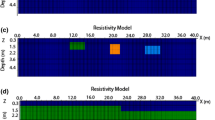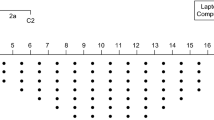Abstract
Conventional artificial neural networks used to solve electrical resistivity imaging (ERI) inversion problem suffer from overfitting and local minima. To solve these problems, we propose to use a pruning Bayesian neural network (PBNN) nonlinear inversion method and a sample design method based on the K-medoids clustering algorithm. In the sample design method, the training samples of the neural network are designed according to the prior information provided by the K-medoids clustering results; thus, the training process of the neural network is well guided. The proposed PBNN, based on Bayesian regularization, is used to select the hidden layer structure by assessing the effect of each hidden neuron to the inversion results. Then, the hyperparameter α k , which is based on the generalized mean, is chosen to guide the pruning process according to the prior distribution of the training samples under the small-sample condition. The proposed algorithm is more efficient than other common adaptive regularization methods in geophysics. The inversion of synthetic data and field data suggests that the proposed method suppresses the noise in the neural network training stage and enhances the generalization. The inversion results with the proposed method are better than those of the BPNN, RBFNN, and RRBFNN inversion methods as well as the conventional least squares inversion.
Similar content being viewed by others
References
Bensaid, A. M., Hall, L. O., Bezdek, J. C., et al., 1996, Validity-guided (re) clustering with applications to image segmentation: Fuzzy Systems, IEEE Transactions on, 4(2), 112–123.
Calderón-Macías, C., Sen, M. K., and Stoffa, P. L., 2000, Artificial neural networks for parameter estimation in geophysics: Geophysical Prospecting, 48(1), 21–47.
Chen, S., Chng, E., and Alkadhimi, K., 1996, Regularized orthogonal least squares algorithm for constructing radial basis function networks: International Journal of Control, 64(5), 829–837.
Chen, X. B., Zao, G. Z., Tang, J., et al., 2005, An adaptive regularized inversion algorithm for magnetotelluric data: Chinese Journal Geophysics, 48(4), 937–946.
Chen, X., Yu, P., Zhang, L. L., et al., 2011, Adaptive regularized synchronous joint inversion of MTand seismic data: Chinese Journal Geophysics, 54(10), 2673–2681.
Dai, Q. W., and Jiang, F. B., 2013, Nonlinear inversion for electrical resistivity tomography based on chaotic oscillation PSO-BP algorithm:The Chinese Journal of Nonferrous Metals, 23(10), 2897–2904.
El-Qady, G., and Ushijima, K., 2001, Inversion of DCresistivity data using neural networks: Geophysical Prospecting, 49(4), 417–430.
Gribenko, A., and Zhdanov, M., 2007, Rigorous 3D inversion of marine CSEM data based on the integral equation method: Geophysics, 72(2), WA73–WA84.
Hecht-Nielsen, R., 1988, Neurocomputing: picking the human brain: Spectrum, IEEE, 25(3), 36–41.
Ho, T. L., 2009, 3-D inversion of borehole-to-surface electrical data using a back-propagation neural network: Journal of Applied Geophysics, 68(4), 489–499.
Lesur, V., Cuer, M., Straub, A., et al., 1999, 2-D and 3-D interpretation of electrical tomography measurements, Part 2: The inverse problem: Geophysics, 64(2), 396–402.
Liu, M., Liu, X., Wu, M., et al., 2011, Integrating spectral indices with environmental parameters for estimating heavy metal concentrations in rice using a dynamic fuzzy neural-network model: Computers & Geosciences, 37(10), 1642–1652.
Loke, M., and Barker, R., 1995, Least-squares deconvolution of apparent resistivity pseudosections: Geophysics, 60(6), 1682–1690.
MacKay, D. J., 1992, Bayesian interpolation: Neural computation, 4(3), 415–447.
Maiti, S., Erram, V. C., Gupta, G., et al., 2012, ANN based inversion of DCresistivity data for groundwater exploration in hard rock terrain of western Maharashtra (India): Journal of Hydrology, 46(4), 294–308.
Neyamadpour, A., Taib, S., and Wan Abdullah, W. A. T., 2009, Using artificial neural networks to invert 2D DCresistivity imaging data for high resistivity contrast regions: A MATLAB application: Computers & Geosciences, 35(11), 2268–2274.
Park, H. S., and Jun, C. H., 2009, A simple and fast algorithm for K-medoids clustering: Expert Systems with Applications, 36(2), 3336–3341.
Pidlisecky, A., and Knight, R., 2008, FW2_5D: A MATLAB 2.5-D electrical resistivity modeling code: Computers & Geosciences, 34(12), 1645–1654.
Shima, H., 1992, 2-D and 3-D resistivity image reconstruction using crosshole data: Geophysics, 57(10), 1270–1281.
Srinivas, Y., Raj, A. S., Oliver, D. H., et al., 2012, A robust behavior of Feed Forward Back propagation algorithm of Artificial Neural Networks in the application of vertical electrical sounding data inversion: Geoscience Frontiers, 3(5), 729–736.
Xu, H. L., and Wu, X. P., 2006, 2_D resistivity inversion using the neural network method:Chinese Journal Geophysics, 49(2), 584–589.
Zhang, L. Y., and Liu, H. F., 2011, The application of ABP method in high-density resistivity method inversion: Chinese Journal Geophysics, 54(1), 227–233.
Author information
Authors and Affiliations
Corresponding author
Additional information
This work was supported by the National Natural Science Foundation of China (Grant No. 41374118), the Research Fund for the Higher Education Doctoral Program of China (Grant No. 20120162110015), the China Postdoctoral Science Foundation (Grant No. 2015M580700), the Hunan Provincial Natural Science Foundation, the China (Grant No. 2016JJ3086), the Hunan Provincial Science and Technology Program, China (Grant No. 2015JC3067), the Scientific Research Fund of Hunan Provincial Education Department, China (Grant No. 15B138).
Jiang Fei-Bo, Ph.D. graduated from Central South University in 2014. His main research interests are forward electromagnetic modeling and inversion, and artificial intelligence. He is presently a lecturer at the College of Physics and Information Science at Hunan Normal University. Email: jiangfeibo@126.com
Rights and permissions
About this article
Cite this article
Jiang, FB., Dai, QW. & Dong, L. Nonlinear inversion of electrical resistivity imaging using pruning Bayesian neural networks. Appl. Geophys. 13, 267–278 (2016). https://doi.org/10.1007/s11770-016-0561-1
Received:
Revised:
Published:
Issue Date:
DOI: https://doi.org/10.1007/s11770-016-0561-1




